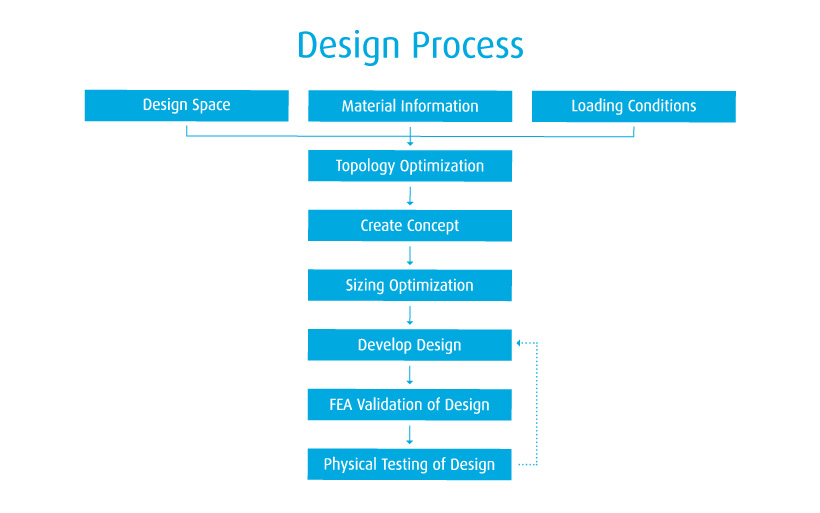Tool Up for Design Success
The development of a design from the first steps of defining requirements to the final step when it is ready for production is often a lengthy and iterative process. Gaining an early understanding of what a design should look like to meet structural requirements is a valuable advantage and streamlines the process.
Altair offers tools that aid this development process and the many phases involved. Depending on the complexity of the problem at hand, different tools can be used based on input data and simulation expertise. With these tools, design engineers will improve the structural performance of their design and reduce the development cycle.
How it Works
The first step of the design process is to determine the main load paths of the structure by performing a topology optimization. This requires the input of the:
- Design space available
- Material information
- Loading conditions
The outcome of this optimization is an architecture that is interpreted into a concept that will then be manufactured.
The architecture, however, is not always representative of the size of its members. It is useful to perform a sizing optimization on the preliminary concept to determine the geometry and dimensions of the cross-sections defined for the part.
Finally, a design is created based on this size output in the previous step. This can later be validated by simulation and physical testing.

Altair’s Design Toolset
With the Altair HyperWorks™ suite of software tools, this design process is possible.
- Altair Inspire™ has the capability to define design space, material properties and loading conditions. After this is done, the topology optimization can be executed. The design capabilities also allow concept creation and FEA validation, all in a powerful and intuitive interface.
While Altair Inspire is a powerful tool, there are some aspects of the design process it currently does not support. Some structures require nonlinearities to be considered in the design process, like nonlinear material (progressive damage and failure of composites) and nonlinear loading (press fit). Altair Inspire also does not perform true sizing optimization. Engineers can leverage CAD capabilities integrated in Altair Inspire to manually iterate the design and validate each iteration through the integrated simulation capabilities, which is limited to linear analysis.
- Some of the obstacles mentioned above can be solved with Altair OptiStruct™. Topology optimization can be performed in OptiStruct with minor non-linear loading conditions and linear material models. It also can be used to perform the sizing optimization, often required after the topology optimization, to quickly determine the proper size of the components.
It is important to note that the lack of nonlinear failure models in OptiStruct would require adequate testing to validate the design. While OptiStruct can tackle more complex problems compared to Inspire, OptiStruct requires some FEA expertise and does not include the CAD capabilities that are available in Altair Inspire.
- Altair Multiscale Designer™ (MDS) can be used to develop the nonlinear material characterization for a given material (progressive damage and failure) starting from the data of the material’s coupon tests. This high-fidelity material model can be used in conjunction with OptiStruct to predict a more accurate response of the design. As a result, only minimal testing is required to validate the design.
Improving the accuracy of the input in the design process will always reduce the costly validation done through physical testing. For complex problems requiring the consideration for non-linear loading and non-linear material behavior, OptiStruct in conjunction with Altair Multiscale Designer provides a solution that leads to minimal physical testing.
For simpler linear problems, Inspire is the ideal tool for the design process and offers both topology optimization and design capabilities.
For more complex models, OptiStruct can be introduced if someone with FEA experience is involved. This will require less physical testing than a design developed with Altair Inspire.
To produce a design that would require the least amount of physical testing, a user with FEA experience would use OptiStruct in combination with Altair Multiscale Designer.

Each tool brings different assets to the table and depending on the project at hand, one tool may be more valuable than the other. If you would like to speak to a technical expert and learn more about any of these solutions or what tool would work best for your project, request a technical meeting here.




